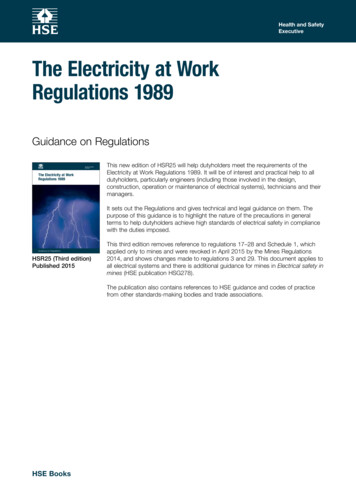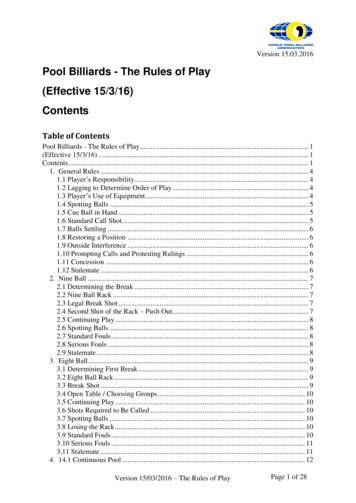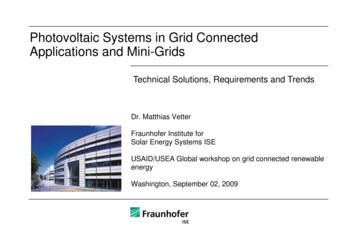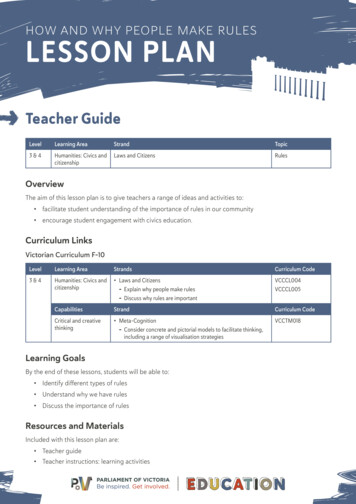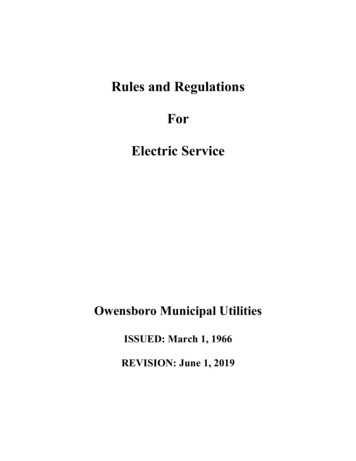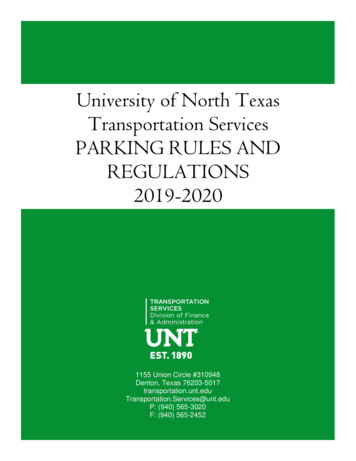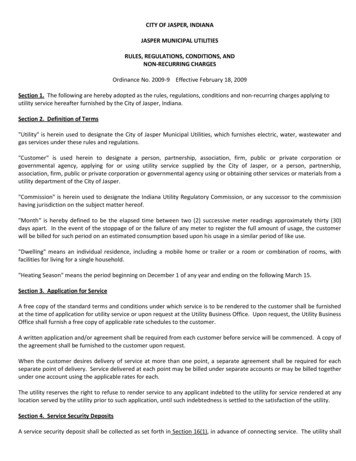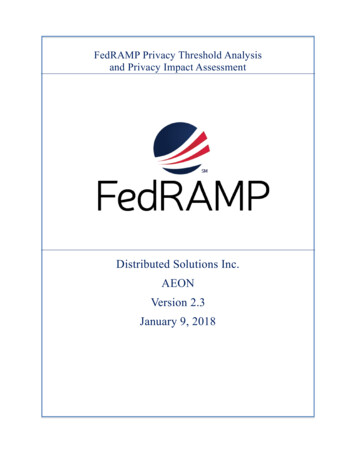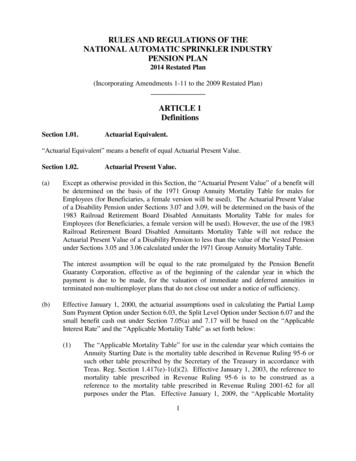
Transcription
RULES AND REGULATIONS OF THENATIONAL AUTOMATIC SPRINKLER INDUSTRYPENSION PLAN2014 Restated Plan(Incorporating Amendments 1-11 to the 2009 Restated Plan)ARTICLE 1DefinitionsSection 1.01.Actuarial Equivalent.“Actuarial Equivalent” means a benefit of equal Actuarial Present Value.Section 1.02.(a)Actuarial Present Value.Except as otherwise provided in this Section, the “Actuarial Present Value” of a benefit willbe determined on the basis of the 1971 Group Annuity Mortality Table for males forEmployees (for Beneficiaries, a female version will be used). The Actuarial Present Valueof a Disability Pension under Sections 3.07 and 3.09, will be determined on the basis of the1983 Railroad Retirement Board Disabled Annuitants Mortality Table for males forEmployees (for Beneficiaries, a female version will be used). However, the use of the 1983Railroad Retirement Board Disabled Annuitants Mortality Table will not reduce theActuarial Present Value of a Disability Pension to less than the value of the Vested Pensionunder Sections 3.05 and 3.06 calculated under the 1971 Group Annuity Mortality Table.The interest assumption will be equal to the rate promulgated by the Pension BenefitGuaranty Corporation, effective as of the beginning of the calendar year in which thepayment is due to be made, for the valuation of immediate and deferred annuities interminated non-multiemployer plans that do not close out under a notice of sufficiency.(b)Effective January 1, 2000, the actuarial assumptions used in calculating the Partial LumpSum Payment Option under Section 6.03, the Split Level Option under Section 6.07 and thesmall benefit cash out under Section 7.05(a) and 7.17 will be based on the “ApplicableInterest Rate” and the “Applicable Mortality Table” as set forth below:(1)The “Applicable Mortality Table” for use in the calendar year which contains theAnnuity Starting Date is the mortality table described in Revenue Ruling 95-6 orsuch other table prescribed by the Secretary of the Treasury in accordance withTreas. Reg. Section 1.417(e)-1(d)(2). Effective January 1, 2003, the reference tomortality table prescribed in Revenue Ruling 95-6 is to be construed as areference to the mortality table prescribed in Revenue Ruling 2001-62 for allpurposes under the Plan. Effective January 1, 2009, the “Applicable Mortality1
Table” shall be the mortality table, modified as appropriate by the Secretary of theTreasury, based on the mortality table specified for the Plan Year undersubparagraph (A) of Code §430(h)(3) (without regard to subparagraph (C) or (D)of such section).(2)Section 1.03.In accordance with the Pension Protection Act of 2006, “Applicable InterestRate” for Plan Years beginning January 1, 2008 is based on the segment rates ascomputed under Internal Revenue Code Section 430(h)(2), but determinedwithout regard to a 24-month average. The segment rates are for the month ofAugust preceding the Plan Year that contains the Effective Date of pension.However, for Plan Years ending prior to January 1, 2012, these segment rates areblended with the applicable rate of Internal Revenue Code Section417(e)(3)(A)(ii)(II) as in effect for Plan Years beginning in 2008, where theblending ratio depends on the Plan Year. The stability period, within the meaningof Treas. Reg. §1.417(e)-1(d)(4)(ii), shall be one Plan Year.Association.“Association” means the National Fire Sprinkler Association, Inc. of Patterson, New York, amembership corporation organized under the laws of the State of Delaware.Section 1.04.Beneficiary.“Beneficiary” means a person who is:(a)legally entitled to receive benefits under this Plan because of his or her designation forthose benefits by a Participant or Retiree under the provisions of Section 3.17 or by theterms of the Plan under the provisions of Section 3.18; or(b)legally entitled to receive benefits by law.For purposes of Code Section 401(a)(9), a “Designated Beneficiary” is an individual who isdesignated as a Beneficiary in accordance with this Plan and otherwise satisfies the requirementsof Code Section 401(a)(9) and § 1.401(a)(9)-4 of the Treasury Regulations.Section 1.05.Calendar Year.“Calendar year” means the period from January 1 through the next December 31. For purposes ofERISA regulations, the calendar year is the vesting computation period, the benefit accrualcomputation period, and, after the initial period of employment, the computation period foreligibility to participate in the Plan. The Calendar Year is the Plan Year for the Plan.2
Section 1.06.Collective Bargaining Agreement.“Collective Bargaining Agreement” or “Agreement” means the Collective Bargaining Agreementsbetween the National Fire Sprinkler Association, Inc. and the Union together with anymodifications, supplements, amendments or successor agreements thereto and it will also mean anycollective bargaining agreement between an Employer engaged in the Sprinkler Industry and aParticipating Sprinkler Local Union which provides for contributions to this Pension Plan.Section 1.07.Contributing Employer.“Contributing Employer” or “Employer” means any employing unit which is a contractor memberof the Fire Sprinkler Association or any other employing unit subject to an Agreement and requiredthereby to make periodic payments to the Fund provided:(a)the employer has been accepted as a Contributing Employer by the Trustees, and(b)the Trustees have not, by resolution, terminated the employer’s status as a “ContributingEmployer” pursuant to Section 12.04 because the employer has failed for a period of ninety(90) days after the due date to make contributions to the Fund as provided for in itsAgreement.Employer also includes Participating Sprinkler Local Unions and other employers participating inthe Fund pursuant to an agreement with the Trustees. Except as may otherwise be required by law,an employer will not be deemed a Contributing Employer simply because it is part of a controlledgroup of corporations or of a trade or business under common control, some other part of which is aContributing Employer.Section 1.08.Contribution Period.“Contribution Period” means the period during which the employer is a Contributing Employer,with respect to a unit or classification of employees.Section 1.09.Covered Employment.“Covered Employment” means employment of an Employee by an Employer in a category coveredby a Collective Bargaining Agreement for which the Employer is obligated by its Agreement tocontribute to the Fund. “Covered Employment” also means employment of an Employee by anEmployer in a category of work for which the Employer is obligated to make contributions to theFund pursuant to an agreement with the Trustees or as required by applicable law.“Covered Employment” does not, however, include employment by an employer after terminationof the employer’s status as a Contributing Employer, for failure to pay contributions due, pursuantto the provisions of Section 12.04.3
Section 1.10.Employee.“Employee” means a person who is an Employee of an Employer and on whose behalf paymentsare required to be made to the Fund pursuant to a Collective Bargaining Agreement as defined inSection 1.06, pursuant to an agreement with the Trustees or as required by applicable law or as theterm “Employee” is additionally defined in the Trust Agreement. The term “Employee” does notinclude any self-employed person or any person who has a direct or indirect interest in a soleproprietorship or partnership which is a Contributing Employer. The term “Employee” may includea person who is an officer or owner or the relative of an officer or owner of an incorporatedemployer or a relative of an owner of an unincorporated employer, or who is otherwise involved inthe management of an Employer pursuant to rules adopted by the Trustees in accordance with theTrust Agreement.Section 1.11.ERISA and “Code”“ERISA” means the Employee Retirement Income Security Act of 1974, as amended. “Code”means the Internal Revenue Code of 1986 as amended.Section 1.12.Hour of Service.An “Hour of Service” is each hour for which an Employee is paid, or entitled to payment, by theEmployer(s), directly or indirectly, including payments for disability from the National AutomaticSprinkler Industry Welfare Fund as well as each hour for which back pay, regardless of mitigationof damages, is awarded or agreed to by an Employer, to the extent that such award or agreement isintended to compensate an Employee for periods during which the Employee would have beenentitled to compensation. However, Hours of Service do not include any time compensated under aworkmen’s compensation or unemployment compensation law or a plan pursuant to a mandatorydisability benefits law and excluding any hours for non-work time in excess of 501 in any onecontinuous period. Two periods of paid non-work time will be deemed continuous if they arecompensated for the same reason (e.g. disability) and are not separated by at least ninety days.Hours of Service are computed and credited in accordance with Department of Labor Regulations2530.200b.Section 1.13.Normal Retirement Age.“Normal Retirement Age” means age 65 or, if later, the age of the Participant on the fifthanniversary of his participation. Participation before a Permanent Break in Service is not counted.Section 1.14.Participant.“Participant” means a Pensioner or an Employee who meets the requirements for participation inthe Plan set forth in Article 2, or a former Employee who has acquired a right to a pension underthis Plan.4
Section 1.15.Participating Sprinkler Local Union or Union.“Participating Sprinkler Local Union” or “Union” means Local 669 and any other SprinklerfitterLocal Union affiliated with the United Association of Journeymen and Apprentices of the Plumbingand Pipefitting Industry of the United States and Canada that participate in the Fund in a manneracceptable to the Trustees.Section 1.16.Participation Date.“Participation Date” means the date a Participating Sprinkler Local Union begins participating inthe Plan.Section 1.17.Pension Fund.“Pension Fund” or “Fund” means the National Automatic Sprinkler Industry Pension Fundestablished under the Trust Agreement.Section 1.18.Pension Plan or Plan.“Pension Plan” or “Plan” means this document as adopted by the Trustees and as thereafteramended by the Trustees.Section 1.19.Pensioner.“Pensioner” means a person to whom a pension under this Plan is being paid or to whom a pensionwould be paid but for time for administrative processing or suspension of benefits.Section 1.20.Trust Agreement.“Trust Agreement” means the Trust Agreement establishing the National Automatic SprinklerIndustry Pension Fund, made and entered into on January 17, 1957, and as thereafter amended andrestated.Section 1.21.Trustees.“Trustees” means the individuals serving as members of the Board of Trustees as established andconstituted from time to time in accordance with the Trust Agreement.Section 1.22.Other Terms.Other terms are specifically defined as follows:Term(a)Break in Continuity(b)Break in Service (One-Year Break in Service,Permanent Break in Service)5Section(s)7.06 (c)4.03
t)(uu)Collectively Bargained EmployeeCompensationContinuous EmploymentDetermination DateDate of DisabilityDisability PensionDisabled from his OccupationDirect RolloverDisqualifying EmploymentDistributeeDistribution Calendar YearEarly Retirement PensionEffective Date of PensionElection PeriodEligible Retirement PlanEligible Rollover DistributionGenderHighly Compensated EmployeeHusband-and-Wife PensionKey EmployeeLimitation YearLife ExpectancyNon-Collectively Bargained EmployeeNon-Key EmployeeNon-Standard RatePartial PensionsParticipation Date (of Sprinkler Local Unions)Payment OptionsPension CreditsPermissive Aggregation GroupPre-Retirement Surviving Spouse PensionQualified SpouseRegular PensionRelated PlanRequired Aggregation GroupRequired Beginning DateRetired or RetirementRetroactive Effective DateSpouseStandard RateSuper Top HeavySuspensionTop Heavy CompensationTop Heavy GroupTop Heavy 103.07(a)(4)(E)7.05(i)(4)7.08(a) and (b)7.05(i)(3)7.05(h)(1)(B)3.03 and 2(b)7.06(d)3.11-3.134.07Article 64.019.02(e)5.035.02(b), 5.03(b)3.01 and (d)9.03(d)(2)7.08(c)9.02(f)9.02(h)9.02(g)
(vv)(ww)(xx)(yy)Totally and Permanently DisabledVested PensionVested StatusYear of Vesting Service3.07(b)3.05 and 3.067.104.027
ARTICLE 2ParticipationSection 2.01.Participation.An Employee who is engaged in Covered Employment during the Contribution Period becomes aParticipant in the Plan on the earliest January 1 or July 1 following completion of a consecutivetwelve (12) month period during which he completed at least 950 Hours in Covered Employment.Once an Employee has become a Participant, the provisions of this Plan give him credit inaccordance with the rules of the Plan for some or all of his service before he became a Participant.Section 2.02.Termination of Participation.A person who has a One-Year Break in Service (defined in Section 4.03) ceases to be a Participantas of the last day of the Calendar Year which constituted the One-Year Break, unless the Participanthas the right to an immediate or deferred pension (other than for disability).Section 2.03.Reinstatement of Participation.An Employee who has lost his status as a Participant in accordance with Section 2.02 becomes aParticipant again by meeting the requirements of Section 2.01 within a Calendar Year on the basisof Hours of Service after the Calendar Year during which his participation terminated. However, inthe case of a non-vested Employee who has not had a Permanent Break in Service under Section4.03(c) of the Plan, that employee becomes a Participant again when he completes at least 950Hours in Covered Employment within a consecutive twelve (12) month period measured from thedate of his re-employment in Covered Employment. Participation will be retroactive to the date ofthe Employee’s re-employment in Covered Employment.8
ARTICLE 3Pension Eligibility and AmountsSection 3.01.Regular Pension - Eligibility.A Participant may retire on a Regular Pension if he meets the following requirements:(a)he has reached age 61; and(b)he has at least fifteen (15) Pension Credits, five (5) of which were earned during theContribution Period.Section 3.02.(a)(b)Regular Pension - Amount.For pensions effective on or after January 1, 2001, the amount of the Regular Pension for aParticipant will be the sum of the following, subject to the provisions of Section 7.06.(1) 15.00 for each of the Participant’s Pension Credits granted for employment prior tothe Contribution Period;(2) 72.00 for each of the Participant’s Pension Credits earned during the ContributionPeriod up to December 31, 1974; and(3) 110.00 for each of the Participant’s Pension Credits earned after January 1, 1975.For purposes of Sections 7.06 and 3.09, the applicable benefit rate is:Benefit Rate Per Pension Credit For:Separation fromCovered EmploymentPast ServiceBefore 1969During 1969During 1970-72During 1973During 1974During 1975-76During 1977During 1978During 1979During 1980During 1981During 1982During 1983 .0013.0013.00Future ServicePrior to 1975 .0020.0024.009Future ServiceAfter 1974 ----------14.5016.0018.0020.0026.0030.0038.0042.00
During 1984During 1985During 1986During 1987During 1988During 1989During 1990During 1991During 1992During 1993During 1994During 1995During 1996-1997During 1998During 1999During 2000During 2001 and 2.00109.00110.00For purposes of Sections 7.06 and 3.09, the applicable benefit rate under the DefaultSchedule is 67.00 per Pension Credit for Future Service earned on and after the effectivedate of the Default Schedule. The effective date of the Default Schedule is defined inSection 3.04(c)(3).Section 3.03.Early Retirement - Eligibility.A Participant may retire on an Early Retirement Pension if he meets the following requirements:(a)has reached age 55; and(b)has at least fifteen (15) Pension Credits, five (5) of which were earned during theContribution Period.Section 3.04.Early Retirement Pension Amount.(a)Prior to Rehabilitation Plan: The monthly amount of the Early Retirement Pension is theamount of the Regular Pension reduced by one-twelfth of one percent (1/12 of 1%) for eachmonth by which the commencement of the pension precedes the month the Participant willreach age 61.(b)Preferred Schedule of the Rehabilitation Plan:(1)The monthly amount of the Early Retirement Pension for an Active Participant whohas a Pension Effective Date on or after January 1, 2010 is the amount of theRegular Pension reduced by one-sixth of one percent (1/6 of 1%) for each month bywhich the commencement of the pension precedes the month the Active Participant10
will reach age 61.(2)The monthly amount of the Early Retirement Pension for a Terminated VestedParticipant who has a Pension Effective Date on or after June 1, 2009 is the amountof the Pension to which the Participant is entitled at Normal Retirement Age reducedby applying the full actuarial equivalent reduction for each month by which thecommencement of the pension precedes the month the Terminated VestedParticipant will reach age 65. The early retirement reduction for benefitscommenced prior to age 65 are as follows:Age at RetirementReduction Applied to Pensionat Normal Retirement .51765833355 years55 years, 1 month55 years, 2 months55 years, 3 months55 years, 4 months55 years, 5 months55 years, 6 months55 years, 7 months55 years, 8 months55 years, 9 months55 years, 10 months55 years, 11 months56 years56 years, 1 month56 years, 2 months56 years, 3 months56 years, 4 months56 years, 5 months56 years, 6 months56 years, 7 months56 years, 8 months56 years, 9 months56 years, 10 months56 years, 11 months57 years57 years, 1 month57 years, 2 months57 years, 3 months57 years, 4 months57 years, 5 months57 years, 6 months57 years, 7 months11
57 years, 8 months57 years, 9 months57 years, 10 months57 years, 11 months58 years58 years, 1 month58 years, 2 months58 years, 3 months58 years, 4 months58 years, 5 months58 years, 6 months58 years, 7 months58 years, 8 months58 years, 9 months58 years, 10 months58 years, 11 months59 years59 years, 1 month59 years, 2 months59 years, 3 months59 years, 4 months59 years, 5 months59 years, 6 months59 years, 7 months59 years, 8 months59 years, 9 months59 years, 10 months59 years, 11 months60 years60 years, 1 month60 years, 2 months60 years, 3 months60 years, 4 months60 years, 5 months60 years, 6 months60 years, 7 months60 years, 8 months60 years, 9 months60 years, 10 months60 years, 11 months61 years61 years, 1 month61 years, 2 0.343650.3385250.33340.3276416670.32188333312
61 years, 3 months61 years, 4 months61 years, 5 months61 years, 6 months61 years, 7 months61 years, 8 months61 years, 9 months61 years, 10 months61 years, 11 months62 years62 years, 1 month62 years, 2 months62 years, 3 months62 years, 4 months62 years, 5 months62 years, 6 months62 years, 7 months62 years, 8 months62 years, 9 months62 years, 10 months62 years, 11 months63 years63 years, 1 month63 years, 2 months63 years, 3 months63 years, 4 months63 years, 5 months63 years, 6 months63 years, 7 months63 years, 8 months63 years, 9 months63 years, 10 months63 years, 11 months64 years64 years, 1 month64 years, 2 months64 years, 3 months64 years, 4 months64 years, 5 months64 years, 6 months64 years, 7 months64 years, 8 months64 years, 9 16670.0330333330.02477513
64 years, 10 months64 years, 11 months(3)0.0165166670.008258333Application of the Preferred Schedule:The reduction factors in Section 3.04(b) shall apply to each Active Participant whose mostrecent Covered Employment prior to June 30, 2009 was with an Employer that wassignatory to a Collective Bargaining Agreement, participation agreement, assent agreement,signed stipulation or similar agreement that calls for contributions that are consistent withthose that are required under the Preferred Schedule of the Rehabilitation Plan; providedthat such agreement became effective on or before June 30, 2009; and provided further thatthe Active Participant’s Covered Employment after June 30, 2009 is with an Employer thatis signatory to a Collective Bargaining Agreement, participation agreement, assentagreement, signed stipulation or similar agreement that calls for contributions that areconsistent with those that are required under the Preferred Schedule of the RehabilitationPlan. The early retirement reduction described in the Preferred Schedule for TerminatedVested Participants shall apply to each Terminated Vested Participant who has a PensionEffective Date on or after June 1, 2009.(c)Default Schedule of the Rehabilitation Plan:(1)The monthly amount of the Early Retirement Pension for an Active Participant whohas a Pension Effective Date on or after the effective date of the Default Schedule isthe amount of the Pension to which to Participant is entitled at Normal RetirementAge reduced by 5/12% per month (5% per year) for each month by which thecommencement of the pension precedes the month the Active Participant will reachage 65.(2)The monthly amount of the Early Retirement Pension for a Terminated VestedParticipant who has a Pension Effective Date on or after the effective Date of theDefault Schedule is the amount of the Pension to which to Participant is entitled atNormal Retirement Age reduced by applying the full actuarial equivalent reductionfor each month by which the commencement of the pension precedes the month theTerminated Vested Participant will reach age 65. The early retirement reduction forbenefits commenced prior to age 65 as stated in Section 3.04(b)(2) shall apply.(3)Effective Date of the Default Schedule:The reduction factors in Section 3.04(c) shall apply to each Participant with a PensionEffective Date on or after June 1, 2009; provided that the new Early Retirement reductionfactors shall not apply to benefits paid before the first date that such new factors may beapplied under the Pension Protection Act (PPA). Generally, this means: (i) for TerminatedVested Participants, the change will apply to benefits that are paid on or after June 1, 2009,and (ii) for Active Participants, the change will apply to benefits paid after the date theParticipant’s Employer’s Collective Bargaining Agreement or other agreement provides for14
the Default Schedule or, if later, the date the Default Schedule is imposed on theParticipant’s Employer.(d)Calculation if Participant has Service under both Preferred and Default ScheduleIf a Participant earns benefits under both the Default and Preferred Schedules, the earlyretirement subsidy under the Default Schedule shall apply to the portion of theParticipant’s benefit that is earned under the Default Schedule, and the early retirementsubsidy under the Preferred Schedule shall apply to the portion of the Participant’s benefitthat is earned under the Preferred Schedule. If a Participant earns benefits under both theDefault and Preferred Schedules in a single Calendar Year, the same methodology setforth in Section 7.06(e) shall be used for determining the early retirement subsidy thatshall apply to the Participant’s benefit that is earned under the Default and PreferredSchedules, respectively.(e)Terminated Vested ParticipantsThe early retirement reduction described in the Preferred Schedule for Terminated VestedParticipants shall apply to each Terminated Vested Participant who has a Pension EffectiveDate on or after June 1, 2009.(f)Definitions(1)(i) For purposes of this section, an “Active Participant” is a Participant who hassatisfied the eligibility requirements of Section 3.03 for Early Retirement Benefitsand who is not a “Terminated Vested Participant”.(ii) Effective July 1, 2013, a Participant who satisfies all of the following requirements,can regain or will retain status as an Active Participant for purposes of this section:(A)The Participant’s participation in the NASI Pension Plan before the Break-inContinuity was based on work covered by a Collective Bargaining Agreement;(B)The Participant attained age 50 or older by December 31, 2008;(C)The Participant incurred one or more Breaks-in-Continuity under section7.06(c) during the period January 1, 2008 to December 31, 2013 as a result ofunemployment with the first year of the Break in Continuity commencing no earlierthan 2008;(D)The Participant retires effective January 1, 2008 or later; and(E)The Participant has sufficient Hours in his Hour Bank in Section 4.01(a)(2) forthe Pension Fund to deduct up to 350 hours for no more than two Calendar Yearsbetween January 1, 2008 and December 31, 2013 to prevent a Break-in-Continuity.Hours in a Participant’s Hour Bank applied to prevent a Break-in-Continuity under this15
section are not available to be credited under Section 4.01(a)(2).(2)Section 3.05.For purposes of this section, a “Terminated Vested Participant” is a Participant whohas attained Vested Status and commences retirement benefits after incurring a Breakin Continuity under Section 7.06(c) of the Plan. A Participant will not be aTerminated Vested Participant if the Participant has not incurred a Break inContinuity under Section 7.06(c) of the Plan. A Terminated Vested Participant canregain status as an Active Participant for purposes of this section if, subsequent toincurring a Break in Continuity, the Participant returns to Covered Employment andearns years of vesting service at least equal to the total number of years whichconstituted the Break(s) in Continuity. However, if a Participant is treated asincurring a Break in Continuity under Section 7.06(c) of the Plan and earns PensionCredits after such Break in Continuity but has not regained the status of an ActiveParticipant as described above, the Participant will be treated as a Terminated VestedParticipant with respect to the Pension Credits the Participant earned prior to hisBreak in Continuity, but not with respect to Pension Credits earned after the Break inContinuity (unless the Participant incurs a subsequent Break in Continuity).Vested Pension - Eligibility.A Participant has the right to a Vested Pension at his Normal Retirement Age if he has credit for atleast ten (10) Years of Vesting Service, all of which must be earned during the Contribution Period.A Participant or former Participant with at least ten (10) Years of Vesting Service is eligible for aVested Pension regardless of the provisions of the Plan in effect when he last worked.Effective January 1, 1989, a Participant who earns one (1) or more Hours of Service on or afterJanuary 1, 1989 in Covered Employment not covered by a Collective Bargaining Agreement, hasthe right to a Vested Pension at his Normal Retirement Age if he has at least five (5) Years ofVesting Service, which have not been canceled by a Permanent Break in Service and all of whichmust be earned during the Contribution Period.Effective January 1, 1996, an individual who completes more than one (1) Hour of Service on orafter January 1, 1996 has the right to a Vested Pension at his Normal Retirement Age after hecompletes at least five (5) Years of Vesting Service during the Contribution Period, excludingYears of Service that are not taken into account because of a Permanent Break in Servicedetermined after the application of this provision.Section 3.06.Vested Pension - Amount.The amount of the Vested Pension is the same as the amount of the Regular Pension.16
Section 3.07.(a)Disability Pension: Eligibility and Commencement.A Participant may retire on a Disability Pension if he becomes Totally and PermanentlyDisabled as defined in 3.07(b) below, and he meets the additional requirements of either3.07(a)(1), (2), or (3) below.(1)Attachment to the Industry test.(A)(B)(2)(i)he has at least fifteen (15) Pension Credits, five (5) of which wereearned during the Contribution Period, or(ii)he has at least ten (10) Pension Credits during the contributionPeriod and his disability began on or after January 1, 1980, or(iii)effective January 1, 1996, he has at least ten (10) Pension Creditsduring theContribution Period and his disability began on or afterJanuary 1, 1975 but before January 1, 1980, andhe worked in Covered Employment for at least 500 total Hours in the periodconsisting of the Calendar Year in which he becam
NATIONAL AUTOMATIC SPRINKLER INDUSTRY . PENSION PLAN . 2014 Restated Plan (Incorporating Amendments 1-11 to the 2009 Restated Plan) _ ARTICLE 1 . Definitions . Section 1.01. Actuarial Equivalent. "Actuarial Equivalent" means a benefit of equal Actuarial Present Value. Section 1.02. Actuarial Present Value. (a) Except as otherwise provided in this Section, the "Actuarial Present Value .



